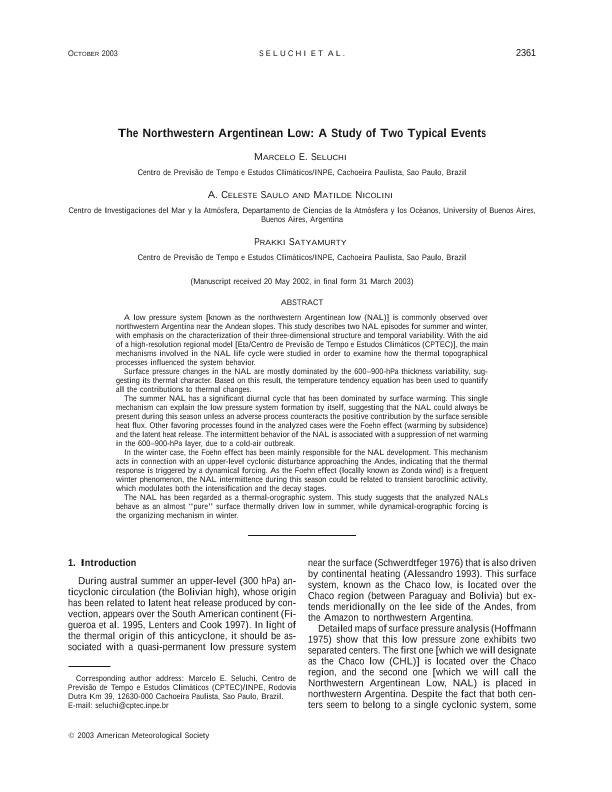Artículo
The Northwestern Argentinean Low: A Study of Two Typical Events
Fecha de publicación:
10/2003
Editorial:
Amer Meteorological Soc
Revista:
Monthly Weather Review
ISSN:
0027-0644
Idioma:
Inglés
Tipo de recurso:
Artículo publicado
Clasificación temática:
Resumen
A low pressure system [known as the northwestern Argentinean low (NAL)] is commonly observed over northwestern Argentina near the Andean slopes. This study describes two NAL episodes for summer and winter, with emphasis on the characterization of their three-dimensional structure and temporal variability. With the aid of a high-resolution regional model [Eta/Centro de Previsa˜o de Tempo e Estudos Clima´ticos (CPTEC)], the main mechanisms involved in the NAL life cycle were studied in order to examine how the thermal topographical processes influenced the system behavior. Surface pressure changes in the NAL are mostly dominated by the 600–900-hPa thickness variability, suggesting its thermal character. Based on this result, the temperature tendency equation has been used to quantify all the contributions to thermal changes. The summer NAL has a significant diurnal cycle that has been dominated by surface warming. This single mechanism can explain the low pressure system formation by itself, suggesting that the NAL could always be present during this season unless an adverse process counteracts the positive contribution by the surface sensible heat flux. Other favoring processes found in the analyzed cases were the Foehn effect (warming by subsidence) and the latent heat release. The intermittent behavior of the NAL is associated with a suppression of net warming in the 600–900-hPa layer, due to a cold-air outbreak. In the winter case, the Foehn effect has been mainly responsible for the NAL development. This mechanism acts in connection with an upper-level cyclonic disturbance approaching the Andes, indicating that the thermal response is triggered by a dynamical forcing. As the Foehn effect (locally known as Zonda wind) is a frequent winter phenomenon, the NAL intermittence during this season could be related to transient baroclinic activity, which modulates both the intensification and the decay stages. The NAL has been regarded as a thermal-orographic system. This study suggests that the analyzed NALs behave as an almost ‘‘pure’’ surface thermally driven low in summer, while dynamical-orographic forcing is the organizing mechanism in winter.
Palabras clave:
ARGENTINA
,
NORTHWESTERN
,
NAL
Archivos asociados
Licencia
Identificadores
Colecciones
Articulos(CIMA)
Articulos de CENTRO DE INVESTIGACIONES DEL MAR Y LA ATMOSFERA
Articulos de CENTRO DE INVESTIGACIONES DEL MAR Y LA ATMOSFERA
Citación
Seluchi, Marcelo Enrique; Saulo, Andrea Celeste; Nicolini, Matilde; Satyamurty, Prakki; The Northwestern Argentinean Low: A Study of Two Typical Events; Amer Meteorological Soc; Monthly Weather Review; 131; 10; 10-2003; 2361-2378
Compartir
Altmétricas




